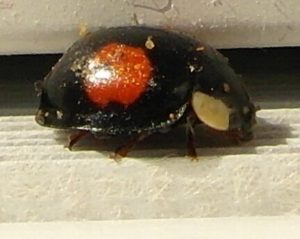
Why are ladybirds asleep on my blinds and shutters? This is a common question, especially during the winter months of the year.
Ladybirds (or Ladybugs) – some historical information
Ladybirds (or Ladybugs) are one of the most recognisable insects in the UK with the most common being the two-spot and the seven-spot ladybirds. As an introduction to this insect, the name ‘ladybird’ or ‘ladybug’ is rather interesting.
It is said that they acquired that name during the Medieval period for the following reason. When thousands of aphids descended on crops in Europe, the farmers prayed to the Virgin Mary for a solution. Shortly after that, a swarm of ladybirds is said to have appeared. They ate their way through all the aphids and the crops were saved.
The farmers were so delighted that they named the pest-eaters “Our Lady’s beetles” with Our Lady referring to the Virgin Mary as she was often depicted in a red cloak. The black spots on ladybirds or ladybugs are believed to represent her sorrows.
Ladybirds (or Ladybugs) – why are they on my Blinds and Shutters?
Ladybirds hibernate during the colder months of the year and usually settle down in the crevices of trees. In the UK this usually happens between December and March. In essence, as the temperature falls they become more and more inactive and go to sleep in a dark corner until the winter is over.
Ladybirds may also come into your home and hide in spaces that are cool and dark. If they have chosen your home to hibernate in, they usually snuggle together in small groups as this allows them to keep their body temperature at a certain level. In settling down for the winter, they aim for areas in your home that are as high as possible and head for the tops of window frames and door frames.
If you have blinds or shutters installed, ladybirds are often found huddled together at the very tops of these products where the temperature is cooler than the atmosphere within the room. The first time you might see them is when you open your blinds or shutters during the winter to help clear the condensation, say, from your windows or to ventilate the room. You will generally find them fast asleep in a little group. As they tend to crawl vertically until they find a cosy place to hibernate for the winter, you may also see them hiding within the cassettes of blinds.
Should I remove the Ladybirds (or Ladybugs) from my Blinds or Shutters?
If you see ladybirds within your home, if they are not in your way, it is best to leave them in peace. You do not need to remove them as they will sleep quite peacefully at the tops of your blinds or shutters until the Spring.
As Spring approaches and the weather gets warmer, they will wake from hibernation and leave your home of their own accord. If you have disturbed them accidentally, just pop them into a dark area and they will go back to sleep.
However, if they have settled down to sleep where you do not want them, simply move them carefully to an area outside your home that is protected from the elements. When they wake from their hibernation, they will fly off to devour aphids and other pests in your garden.
For more information on our Blinds, Shutters, Awnings, Insect Screens:
- see Client Reviews
- email [email protected]
- request a brochure
- request a free design consultation
For other interesting stories from the world of Blinds and Shutters see:

Thank you for this article, very useful and informational.
I’m glad you liked the article. Ladybirds are not the only insects found on blinds and shutters – they just stand out more because of their colour. Joy.